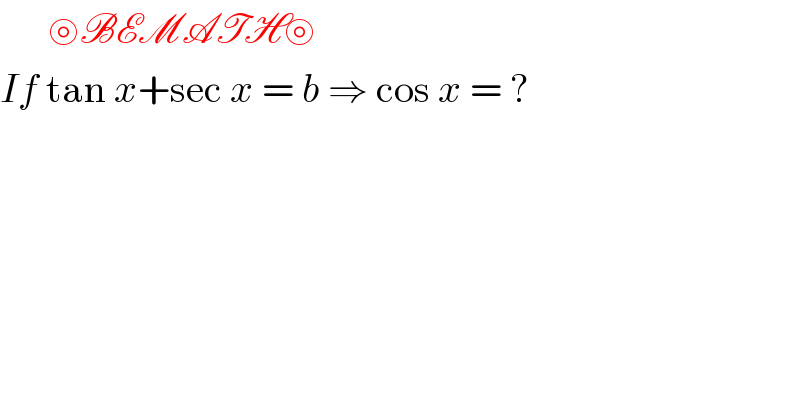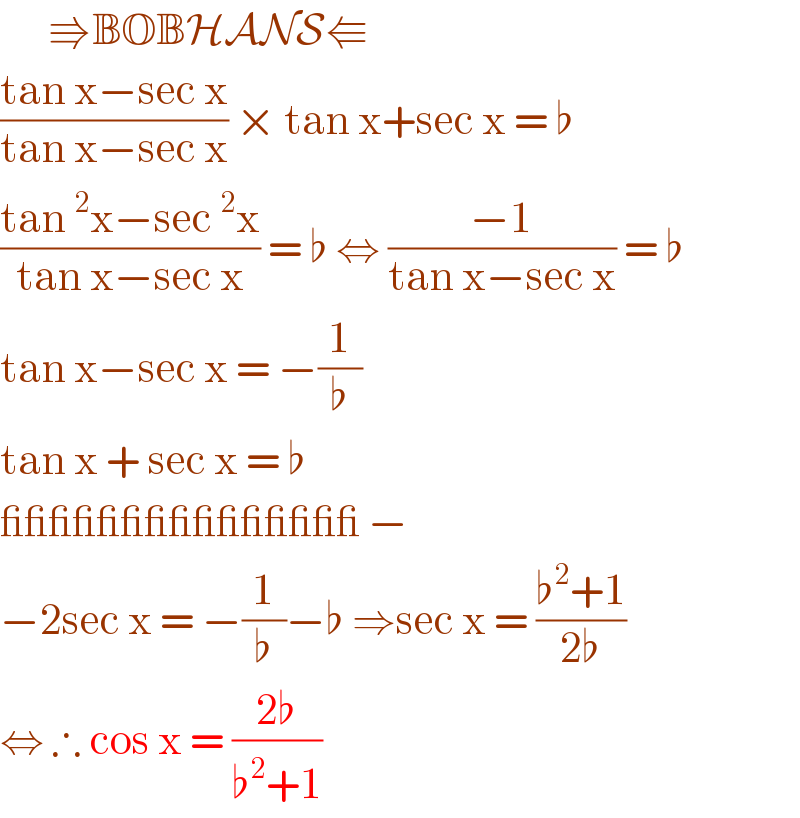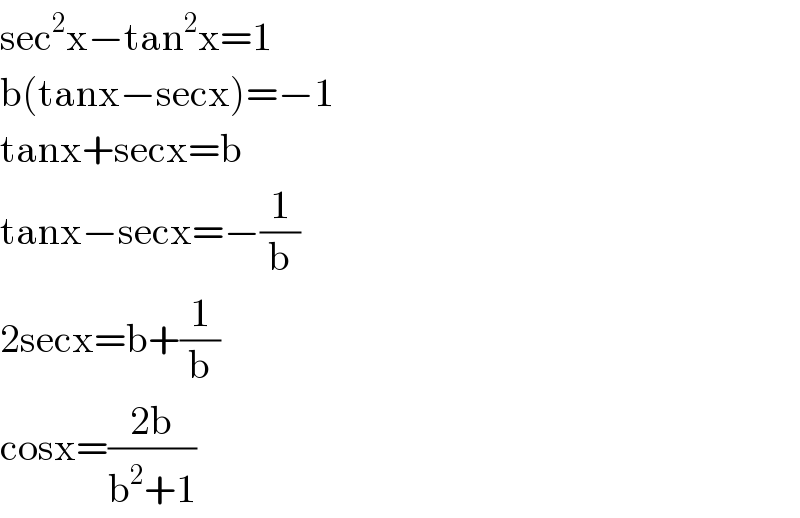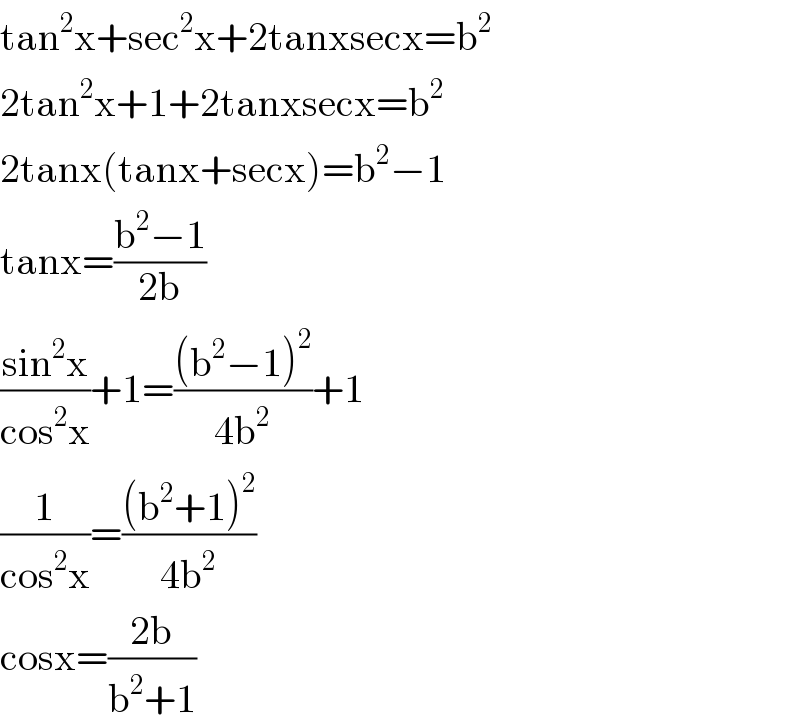Question Number 107364 by bemath last updated on 10/Aug/20

$$\:\:\:\:\:\:\circledcirc\mathscr{BEMATH}\circledcirc\: \\ $$$${If}\:\mathrm{tan}\:{x}+\mathrm{sec}\:{x}\:=\:{b}\:\Rightarrow\:\mathrm{cos}\:{x}\:=\:? \\ $$
Answered by bobhans last updated on 10/Aug/20

$$\:\:\:\:\:\:\Rrightarrow\mathbb{BOB}\mathcal{HANS}\Lleftarrow \\ $$$$\frac{\mathrm{tan}\:\mathrm{x}−\mathrm{sec}\:\mathrm{x}}{\mathrm{tan}\:\mathrm{x}−\mathrm{sec}\:\mathrm{x}}\:×\:\mathrm{tan}\:\mathrm{x}+\mathrm{sec}\:\mathrm{x}\:=\:\flat \\ $$$$\frac{\mathrm{tan}\:^{\mathrm{2}} \mathrm{x}−\mathrm{sec}\:^{\mathrm{2}} \mathrm{x}}{\mathrm{tan}\:\mathrm{x}−\mathrm{sec}\:\mathrm{x}}\:=\:\flat\:\Leftrightarrow\:\frac{−\mathrm{1}}{\mathrm{tan}\:\mathrm{x}−\mathrm{sec}\:\mathrm{x}}\:=\:\flat \\ $$$$\mathrm{tan}\:\mathrm{x}−\mathrm{sec}\:\mathrm{x}\:=\:−\frac{\mathrm{1}}{\flat} \\ $$$$\mathrm{tan}\:\mathrm{x}\:+\:\mathrm{sec}\:\mathrm{x}\:=\:\flat \\ $$$$\_\_\_\_\_\_\_\_\_\_\_\_\_\_\_\:−\: \\ $$$$−\mathrm{2sec}\:\mathrm{x}\:=\:−\frac{\mathrm{1}}{\flat}−\flat\:\Rightarrow\mathrm{sec}\:\mathrm{x}\:=\:\frac{\flat^{\mathrm{2}} +\mathrm{1}}{\mathrm{2}\flat} \\ $$$$\Leftrightarrow\:\therefore\:\mathrm{cos}\:\mathrm{x}\:=\:\frac{\mathrm{2}\flat}{\flat^{\mathrm{2}} +\mathrm{1}}\: \\ $$
Answered by som(math1967) last updated on 10/Aug/20
![sec^2 x−tan^2 x=1 ⇒secx−tanx=(1/b) [∵secx+tanx=b] ∴2secx=b+(1/b) secx=((b^2 +1)/(2b)) ∴cosx=((2b)/(b^2 +1)) ans](https://www.tinkutara.com/question/Q107366.png)
$$\mathrm{sec}^{\mathrm{2}} \mathrm{x}−\mathrm{tan}^{\mathrm{2}} \mathrm{x}=\mathrm{1} \\ $$$$\Rightarrow\mathrm{secx}−\mathrm{tanx}=\frac{\mathrm{1}}{\mathrm{b}}\:\left[\because\mathrm{secx}+\mathrm{tanx}=\mathrm{b}\right] \\ $$$$\therefore\mathrm{2secx}=\mathrm{b}+\frac{\mathrm{1}}{\mathrm{b}} \\ $$$$\mathrm{secx}=\frac{\mathrm{b}^{\mathrm{2}} +\mathrm{1}}{\mathrm{2b}}\:\therefore\mathrm{cosx}=\frac{\mathrm{2b}}{\mathrm{b}^{\mathrm{2}} +\mathrm{1}}\:\mathrm{ans} \\ $$
Answered by Dwaipayan Shikari last updated on 10/Aug/20

$$\mathrm{sec}^{\mathrm{2}} \mathrm{x}−\mathrm{tan}^{\mathrm{2}} \mathrm{x}=\mathrm{1} \\ $$$$\mathrm{b}\left(\mathrm{tanx}−\mathrm{secx}\right)=−\mathrm{1} \\ $$$$\mathrm{tanx}+\mathrm{secx}=\mathrm{b} \\ $$$$\mathrm{tanx}−\mathrm{secx}=−\frac{\mathrm{1}}{\mathrm{b}} \\ $$$$\mathrm{2secx}=\mathrm{b}+\frac{\mathrm{1}}{\mathrm{b}} \\ $$$$\mathrm{cosx}=\frac{\mathrm{2b}}{\mathrm{b}^{\mathrm{2}} +\mathrm{1}} \\ $$
Answered by Dwaipayan Shikari last updated on 10/Aug/20

$$\mathrm{tan}^{\mathrm{2}} \mathrm{x}+\mathrm{sec}^{\mathrm{2}} \mathrm{x}+\mathrm{2tanxsecx}=\mathrm{b}^{\mathrm{2}} \\ $$$$\mathrm{2tan}^{\mathrm{2}} \mathrm{x}+\mathrm{1}+\mathrm{2tanxsecx}=\mathrm{b}^{\mathrm{2}} \\ $$$$\mathrm{2tanx}\left(\mathrm{tanx}+\mathrm{secx}\right)=\mathrm{b}^{\mathrm{2}} −\mathrm{1} \\ $$$$\mathrm{tanx}=\frac{\mathrm{b}^{\mathrm{2}} −\mathrm{1}}{\mathrm{2b}} \\ $$$$\frac{\mathrm{sin}^{\mathrm{2}} \mathrm{x}}{\mathrm{cos}^{\mathrm{2}} \mathrm{x}}+\mathrm{1}=\frac{\left(\mathrm{b}^{\mathrm{2}} −\mathrm{1}\right)^{\mathrm{2}} }{\mathrm{4b}^{\mathrm{2}} }+\mathrm{1} \\ $$$$\frac{\mathrm{1}}{\mathrm{cos}^{\mathrm{2}} \mathrm{x}}=\frac{\left(\mathrm{b}^{\mathrm{2}} +\mathrm{1}\right)^{\mathrm{2}} }{\mathrm{4b}^{\mathrm{2}} } \\ $$$$\mathrm{cosx}=\frac{\mathrm{2b}}{\mathrm{b}^{\mathrm{2}} +\mathrm{1}} \\ $$
